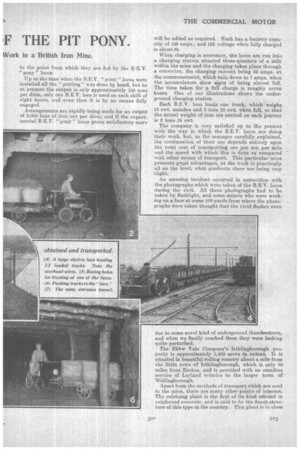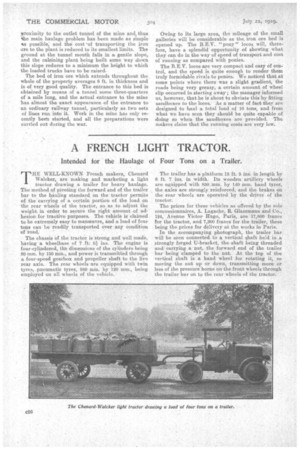THE SUPERSESSK F THE PIT PONY.
Page 10

Page 11

Page 12

If you've noticed an error in this article please click here to report it so we can fix it.
Self-contained Electric Locoi Work in a British Iron Mine.
FOR LONG PAST has the faithful and tireless pit pony performed its monotonous duties under the earth, but the day of its deliverance is, we believe, in sight. Much attention is now being given by well-known engineers, both in the mining and oommereial worlds, to the further development of electrically-driven locomotives which will take the place of the pit ponies. Already vast strides have been made in the installation of electric locomotives working from the pit mouth, and, in certain types of mines, into the main galleries themselves, but it has been found impossible to take the large locomotives intended for outside work into the smaller galleries of the mines.
There are certain prejudices against the use of mechanical transport in the mines, particuiarlytcoal mines, Where there is risk of explosions being caused by sparking in the case of electric installations. We believe, however, that eventually these prejudices will be overcome, and improved means invented for obviating any risk of explosion owing to this cause, as it is not difficult to render safe a self-cOntained electric boo; where, however, the current has to be picked up the prevention of sparking is almost impossible. It is obvious that where mechanical power can be used in lieu of animal or man power, the saving should be great, providing that the locomotives can be kept working all the time and supplied with adequate loads, and the primary cost will not prove so much as many people appear to believe. Light, selfcontained, ,electrically-driven locomotives fitted with accumulators so that the use of overhead wires or other outside means of carrying the current is obviated are not very expensive, and they can be constructed to run over the existing tramlines.
We recently visited the iron mine at Irthlingborough belonging to the Ebbw Vale Steel, Iron and Coal Co., Ltd., where experiments are now being carried out with several small electric locos built by British Electric Vehicles, Ltd., Churchtown Works, Southport. We were cordially welcomed by the genial resident engineer, Mr. T. Falcon, who very kindly conducted us in person through the mine.
Owing to the fact that the electric " pony" locos have been running for about two weeks only and not on full-time work, it is as yet impossible to give figures to show how their work compares as regards speed and cost with that of animal or human means of propulsion. They are being used as feeders from the faces to the main roads in which run the large American electric locomotives with. which the mine is equipped.
One of the photographs which we reproduce shows a large electric loco hauling 12 loaded trucks. The overhead wires from which these locos obtain the necessary current are carried right into the main road or tunnel of the mine, and they run on two sets of rails to the point from which they are fed by the B.E.V. " pony " locos.
Up to the time when the B.E.V. "pony." locos were installed all the " putting " was done by hand, but as at present the output is only approximately 160 tons per diem, only one B.E.V. taco is used on each shift of eight hours, and even then it is by no means fully engaged.
Arrangements are rapidly being made for an output of 2,000 tons of iron ore per diem, and if the experimental B.E.V. " pony " locos prove satisfactory more will be added as required. Each has a battery caps; city of 193 amps., and tht voltage when fully charged is about 65.
When charging is necessary, the locos are run into a charging station situated three-quarters of a mile within the mine and the charging takes place through a converter, the charging current being 34 amps. at the commencement, which tails down to 7 amps. when the accumulators show signs of being almost full. The time taken for a full charge is roughly seven hours. One of our illustrations s.horws the underground charging station.
Each B.E.V. loco hauls one truck, which weighs 15 cwt. unladen and 3 tons 10 cwt. when full, so that the actual weight of iron ore carried on each journey is 2 tons 15 cwt.
The company is very satisfied up to the present with the way in which the B.E.V. locos are doing their work, but, as the manager carefully explained, the continuation of their use depends entirely upon the total cost of transporting ore per ton per mile and the speed with which this is done as compared with other means of transport. This particular mine presents grerat advantages, as the work is practically all on the level, what gradients there are being very slight.
An amusing incident occurred in connection with the photographs which were taken of the B.E.V. locos during the visit. All these photographs had to be taken by flashlight, and some miners who were working on a face at some 100 yards from where the photographs were taken thought that the vivid flashes were due to some novel kind of underground thunderstorm, and when. we finally reached them they were looking quite perturbed. The Ebbw Vale Company's Irthlingborough property is approximately 1,400 acres in extent. It is situated in. beautiful rolling country about a mile from the little town of Irthlingborough, which is only 82 miles from Euston, and is provided with an omnibus service of Leyland vehicles to the larger town of Well ingborough.
Apart from the methods of transport which are used in the mine, there are many other points of interest. The calcining plant is the first of its kind erected in reinforced concrete, and is said to be the finest structure of this type in the country.. This plant is in close isroximity to the outlet tunnel of the mine and, thus be main haulage problem has been made as simple -ts possible, and the cost of transporting the iron ore to the plant is reduced to -its, smallest limits. The ground at the tunnel mouth falls in a gentle slope, and the calcining plant being built some way down this slope reduces to a minimum the height to which the loaded trucks have to be raised.
The bed of iron ore which extends throughout the whole of the property averages 8 ft. in thickness and is of very good quality. The entrance to this bed is obtained by means of a tunnel some three-quarters of `a mile long, and the actual entrance to the mine 'has almost the exact appearance of the entrance to an ordinary railway tunnel, particularly as two sets of lines run into it. Work in the mine has only recently been started, and all the preparations were carried out during the war. Owing to its large area the mileage of the small galleries will be considerable as the, iron ore bed is opened up. The B.E.V. "pony" locos will, therefore, have a splendid opportunity of slaoWing what they can do in the way of speed of transport and cost of running as compared with ponies.
The B.E.V. locos are very compact and easy of eon.trol, and the speed is quite enough to render them truly formidable rivals to ponies. We noticed that at some points where there was a slight gradient, the roads being very greasy, a certain amount of wheel slip occurred in starting away ; the manager informed us, however, that he is abott to obviate this by fitting sandboxes to the locos. • As a matter of fact they are designed to haul a total load of 10 tons, and from what we have seen they should be quite capable. of doing so when the sandboxes are provided. The makers claim that the running costs are very low.






















